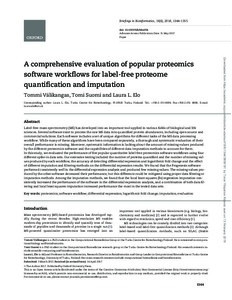A comprehensive evaluation of popular proteomics software workflows for label-free proteome quantification and imputation
Välikangas T; Suomi T; Elo LL
https://urn.fi/URN:NBN:fi-fe2021042612521
Tiivistelmä
Label-free mass spectrometry (MS) has developed into an important tool applied in various fields of biological and life sciences. Several software exist to process the raw MS data into quantified protein abundances, including open source and commercial solutions. Each software includes a set of unique algorithms for different tasks of the MS data processing workflow. While many of these algorithms have been compared separately, a thorough and systematic evaluation of their overall performance is missing. Moreover, systematic information is lacking about the amount of missing values produced by the different proteomics software and the capabilities of different data imputation methods to account for them.In this study, we evaluated the performance of five popular quantitative label-free proteomics software workflows using four different spike-in data sets. Our extensive testing included the number of proteins quantified and the number of missing values produced by each workflow, the accuracy of detecting differential expression and logarithmic fold change and the effect of different imputation and filtering methods on the differential expression results. We found that the Progenesis software performed consistently well in the differential expression analysis and produced few missing values. The missing values produced by the other software decreased their performance, but this difference could be mitigated using proper data filtering or imputation methods. Among the imputation methods, we found that the local least squares (lls) regression imputation consistently increased the performance of the software in the differential expression analysis, and a combination of both data filtering and local least squares imputation increased performance the most in the tested data sets.
© The Author 2017. Published by Oxford University Press.
Kokoelmat
- Rinnakkaistallenteet [27094]
